Dry, the Beloved Counry
Author: Eve Fairbanks
Fairbanks, Eve. “The Unlikely Upside of Cape Town’s Drought.” The Huffington Post, https://highline.huffingtonpost.com/articles/en/cape-town-drought/. Accessed 11 Mar. 2022.
When I moved to South Africa nine years ago, one of the first things some locals told me was to be careful using GPS. The country had rules of navigation, they told me, but ones more complicated and intuitive than a computer could manage. You could drive through this neighborhood, but not at night. You could drive through that one, but roll up your windows, especially if you are white. It was often white South Africans who talked about the GPS, but many black South Africans agreed. It was sad, everybody would say; sad that the once-segregated country seemed not to have fully gotten over its past. But that was the way it was. Those were the rules. Some had come to think of them, painfully, as a fact of nature, of the human race.
I thought of these rules when I flew into Cape Town, South Africa’s second-largest city, in March. Over the last three years, Cape Town has been suffering an extraordinary, once-in-300-years drought—helped along, most analysts surmise, by climate change. The shift in the city’s physical appearance is astonishing. The Cape is cordoned off from the rest of the country by a 5,000-foot-high wall of mountains. To the northeast, the landscape looks like the Africa of safari brochures: dry, hot and then jungly. But in the little bowl-shaped area couched between the mountain range and the southwestern tip of the African continent, the climate is exceptional. Its technical name is “Mediterranean.” To look out from the peaks toward Cape Town, a city of 4 million distinguished by genteel architecture and craggy slopes, has traditionally been like glimpsing Greece, if Greece were even dreamier: ivory houses, cobalt sea, olive hills, all threaded through by ribbons of gold and twinkles of topaz from wine farms. Fed by five times more rainfall than South Africa’s arid central region, the Cape area is one of the most diverse floral kingdoms on Earth, boasting giant blush-colored blooms. Cloud formations, from billowing white cumulonimbus to fogs that flow like rivers to mists that course like waterfalls off the top of Table Mountain, the crag that looms over the city, make heaven seem almost like a real place here, as playful and richly landscaped as the earth below.
Some of that is gone now. Cape Town’s drought palette is a dull lime and beige. Lawns and gardens are dead. The city’s vast townships—spots legally reserved for people of color under apartheid—used to be differentiated from the wealthy neighborhoods that tumble down the Atlantic-facing side of Table Mountain not only by their location, tucked conveniently behind the mountain where they couldn’t easily be seen, but also by their own, less desirable microclimate, marshy and wind-scoured, prone to floods in wet weather and, in the dry and breezy summers, consumed by a cloud of grit. Dust, piled in little drifts in the gutters, was one of those signs that you were heading into a “bad” place. Dust is everywhere now.
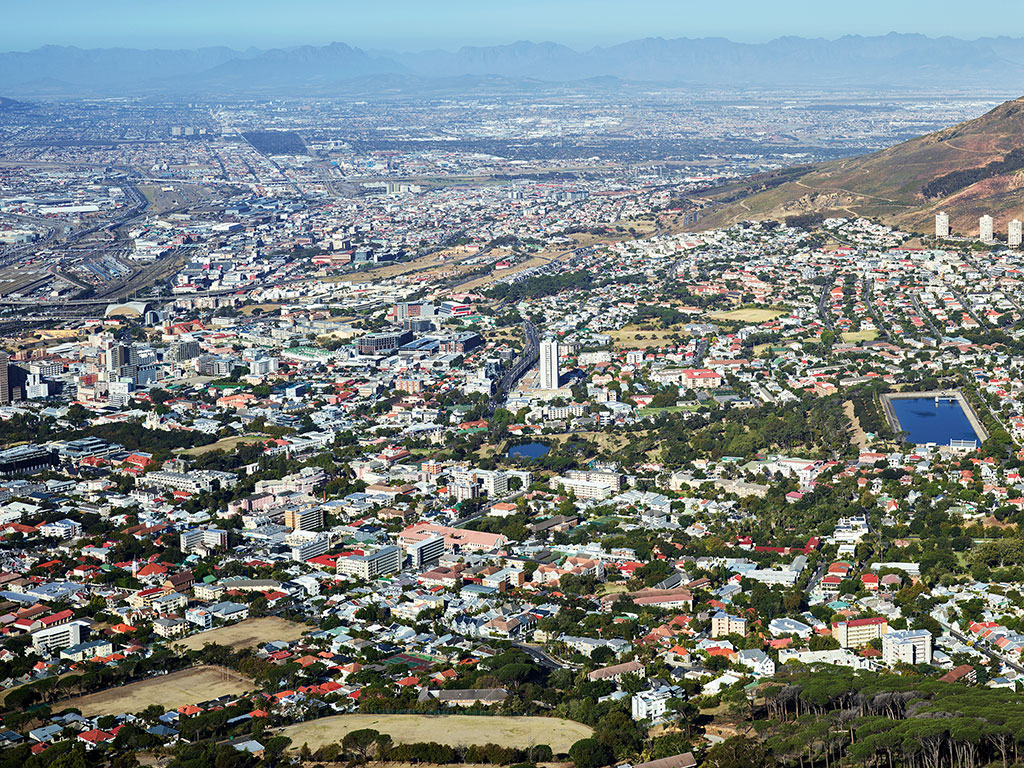
COVER: Cape Town’s largest and most important dam, Theewaterskloof, holds more than half of the area’s water when it’s at capacity. TOP: Cape Town as seen from the top of Lion’s Head, one of the two mountains that give the city’s downtown a bowl-like shape. BOTTOM: A “road” in the semi-desert area outside of town.
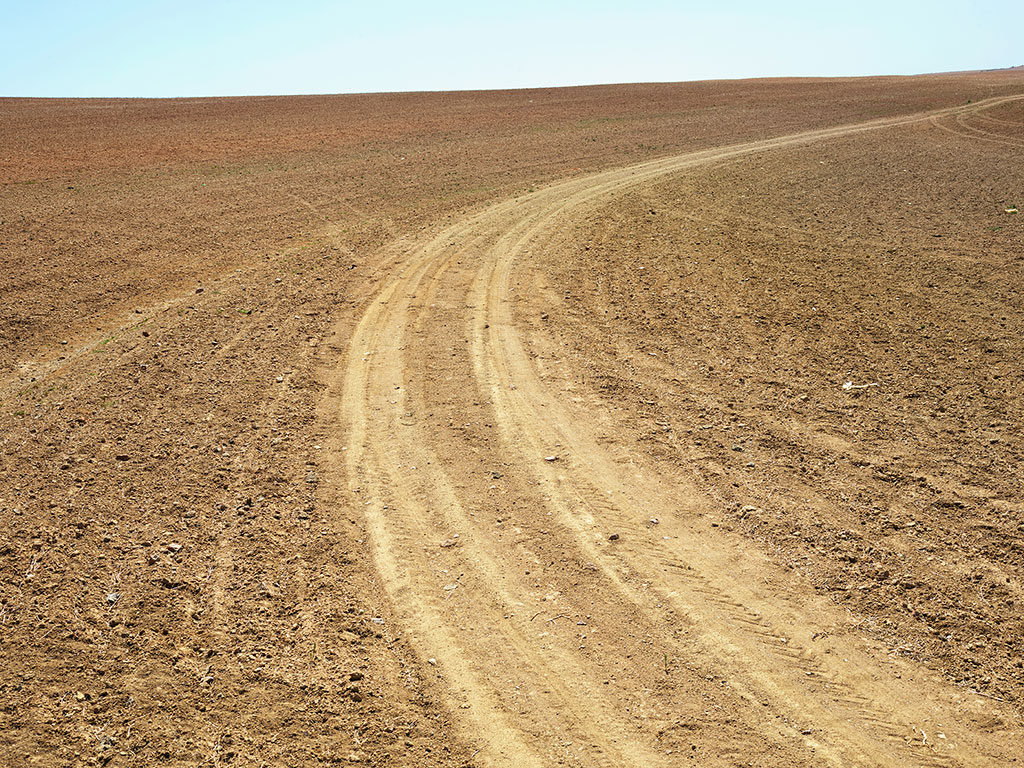
Tourists love Cape Town: It has the second-highest “seasonal fluctuation of multimillionaire population rate” (i.e., summer holidayers with superyachts) after the Hamptons. It’s chic: Tech startups and hip restaurants with names like The Bombay Bicycle Club are all over the place. It’s affluent: Nine out of 10 of South Africa’s richest neighborhoods are here. I occasionally suspect the tourists come because it’s in Africa, and thus exotic, but they don’t really have to deal with many black people. Bantu-speakers had not arrived here by the time the Europeans came. They are migrating to the city now from jobs-starved rural areas to the east, but Cape Town still has an unusually low black population, only 39 percent. Forty-two percent of residents are “coloreds,” mixed-race South Africans with an unplaceably multicultural appearance. The international airport greets visitors with thrilling floor-to-ceiling photographs of vineyards, parades, jazz musicians, eye-popping beaches and zebras—but strikingly few images of the black villages and cityscapes that are the dominant reality for the rest of the continent.
Within South Africa, this identity has given Cape Town a questionable reputation. It is known as a place for South Africans—and foreigners—who don’t want to openly say racist things but who firmly intend to keep a grip on their privilege. Though whites make up only 16 percent of the population, compared to 8 percent of the country at large, they are much more visible here; the bars on upscale avenues and the jewel-toned beach resorts are filled with almost exclusively white patrons. A friend of mine who helped propose a wind farm that would have allowed more migrants to live in the area was defeated by a horde of angry British retirees and white South Africans who claimed to oppose it because it endangered a rare frog, a frog they had probably never heard of before they heard of the development.
Stories of outright discrimination against black people in restaurants abound. Last year, a reserved parking spot in a fancy neighborhood called Clifton went on sale for $83,000. I know Clifton. It’s crowded, but there’s parking. Some buyer probably paid what a typical South African family spends over 23 years for the privilege not to have to deal with “car guards,” the black or colored Capetonians who employ themselves to watch over your car for a quarter.
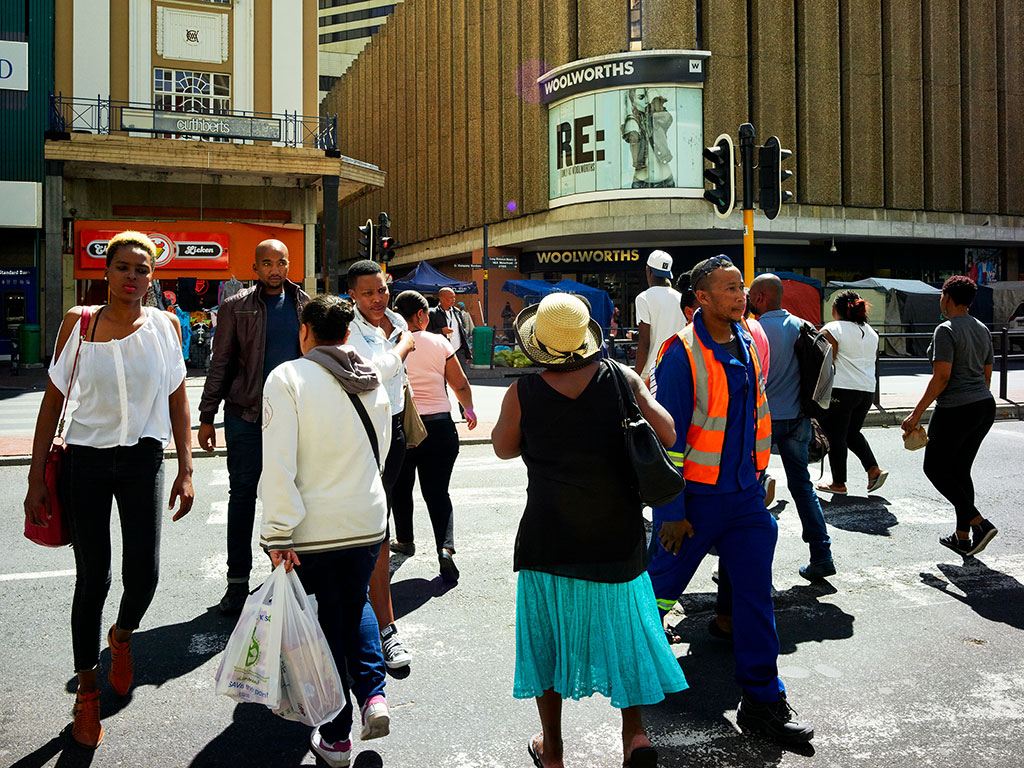
An early spring day on Adderley Street, the main thoroughfare in Cape Town’s business district.
Driving in Johannesburg, I once saw a billboard for a Cape Town real estate company inviting South Africans to “semigrate.” The word was a play on “emigrate,” what many white South Africans have been threatening to do—to a whiter country—since the end of white rule in 1994. The implication was that moving to Cape Town was, more or less, just as good as leaving Africa itself.
This helps explain the strange quiet in the rest of the country about the drought. My friends in Johannesburg rarely talked or seemed to care very much about it. Serves them right for filling up their pools, a few acidly said. Let it become more like the rest of Africa—tougher, harder to eke out a living in—and let them see how it feels. With the coming of “Day Zero,” the day initially predicted for April when the government would have to shut off the taps, “four million people … may have to stand in line surrounded by armed guards,” National Geographic warned. The expectation among South Africans outside of Cape Town was that this might be a poetically just punishment. If Capetonians had wanted so badly to hold on to goodies, from wealth to race privilege, then let their overabundance and its effects drown them. The thought of a person who would pay $83,000 to avoid a car guard sweating in line to gather a bucket of water from a distribution truck was almost pleasurable.
I wrote to my friend Paul, who lives in an apartment in an upper-middle-class neighborhood, to see if I could stay with him in Cape Town. He agreed—but only if I understood what was going on.
What was going on, he suggested, was not just a drought, but a kind of vast, unplanned, crazy—and fabulous—social experiment. “I hope you’ll be game to test your water-saving limits!” he wrote me. “Nothing leaves the flat except via the toilet these days. The sink and bath are plugged ... I can manage the washing machine on the lowest setting, and its output goes into a 25-liter container for additional flushing. It’s all a bit extreme perhaps,” he conceded.
He and his present guest, he said, were each using only about a fifth of the 50 liters per person per day the city government had mandated—which is less than a sixth of the 330 liters the average American uses a day at home. “[But] it’s more of a challenge than a requirement,” he explained. “I’m sort of having fun with this!”
Being able to show a visitor day-old urine ripening in your toilet bowl is a proud moment.
Over the past year, unexpectedly, the city has cut its water consumption by 40 percent. “Bucket showers”—or catching the water in a plastic tub for reuse—are now the norm. Washing dishes in pure water is a luxury; kitchens smell of days-old dishwater. People put out ungainly tanks in their yards to harvest rainwater, smothering whatever grass might be left. Wealthy South Africans, traditionally, have had fastidious cleanliness standards, a way of distinguishing themselves and of tapping the vast labor reserve of cheap maids. Now, being able to show a visitor day-old urine ripening in your toilet bowl, proving you do not flush, is a proud moment. Body odor is less taboo. Many women have radically adjusted their haircare routines: embracing natural curls to diminish the need to wash and style, shampooing only once a week or, as one woman told me in a discussion on a community-run drought Facebook page, “experimenting with spraying my hair lightly” with a plant mister. Others chopped hip-length hair off into bobs or Sinéad O’Connor shaves. A queer friend of mine complained she didn’t know who to hit on because “there are queer haircuts everywhere.”
On the drought Facebook page, which now has 160,000 members, a spirit has arisen of egging each other on. The members, who hail from different classes, call each other “fellow water warriors.” They give each other digital fist-bumps for their low water usage, their “gray water systems,” “submersible pumps” and other odd contraptions they’ve engineered to make their homes more water-wise. The weirder and more DIY the better. Monique and Clint Tarling, a family living just outside the main city, showed me the “sustainable shower” they built out of a 500-liter tank and pallets. Revealing their new priorities, the shower is on their front stoop, and they can no longer enter their house through the main door.

The travel magazine-worthy “sustainable shower” that Clint and Monique Tarling constructed on their front stoop.
Clint rejiggered an old worm farm to be a filter. Monique, a homemaker who fosters abandoned babies—20 in the past six years—discovered that the project became an outlet for creative tendencies, a longing for beauty, she barely knew she had. She decorated their new shower with ferns and waterproof fairy lights. It is magical. Her kids take extra-long showers—the water loops and re-loops—just to be in there.
In a country beset by many sensitivities, and where one person’s idea of a good joke is another person’s unacceptable taunt, a relatively rare public humor abounds on the Facebook page. Fellow residents’ efforts are gently mocked. One woman proudly posted a picture of how she bolted her washing machine onto the bathroom wall so a hose can empty its used water directly into the cistern. “Looks like a gas chamber!” somebody commented.
“Big chance of being killed by a Waschmaschine while having a crap,” said another.
The whole mood was contagious. My first night, I openly gagged when my friend Paul put his hands into my dirty shower water to scoop it out for the toilet. But a day or two into my trip, when I opened a friend’s guest toilet lid to a turd, I nearly squealed with glee. I have never been so thrilled to see a previously deposited piece of shit in a toilet I myself hoped to take a crap in.
We tend to think “norms” take a long time to establish, and a long time to shift. The turd of a stranger, in a well-off place, feels like a basic no-no, a fundamental signal that makes its discoverer feel not only disgusted but also vaguely unsafe, as if the environment is neglected and unsettlingly unruled. But in Cape Town, it had become a totally different symbol: a signifier of responsibility and community-mindedness.
STORMING THE FORTRESSES
I couldn’t quite figure out why certain rules had changed so quickly.
But Deon Smit helped explain part of it to me.
A burly 60-year-old suburbanite with a Tom Selleck mustache, Smit is one of four volunteers who run the Facebook drought page.
It is nearly a full-time job.
“My swimming pool, I can fill it out of my tap, and I’m still going to be under the limit the city has set,” he told me. “But that’s wrong! That’s somebody else’s water I’m taking.”
Smit grew up white under apartheid. He was a firefighter for 33 years before retiring. I asked him why he devoted all day to the page, as well as to exhausting missions to deliver water to farms and old-age homes, even though the work gives him terrible headaches.
When he was a kid, he “had two desires in life,” he explained in his office, as private Facebook messages from fellow water warriors bounced around the computer screen on his painkiller-strewn desk. “One was to become a fireman. And one was to get involved in a project like this, where I can do something for the community.”
In the past, though, it had been unclear what “the community” was. To sustain white rule, the apartheid government claimed the black parts of South Africa were “sovereign countries,” though no other nation recognized them. In South Africa, sometimes, whites still say “they” both to refer to black people and to “bad” people, like shitty politicians or criminals. It is appropriate to complain “They stole my car,” even before you have any idea who stole it.
But people of all races also always had intimate relationships. And they shared an experience, even if it was from different vantage points. Smit felt gratified to be prompted, thanks to the drought, to do something positive for a greater group of people. After apartheid, most whites in South Africa were marked by a faint moral taint. “I don’t know who stays in the old-age home,” he told me, “whether they’re pink, black, yellow, or whatever.” He looked vehement as he said this, as if he was stating something essential to his fellow men, or perhaps to his former self. I got this sense from many in the city. On the Facebook page, a woman named Valerie reflected that the drought made her feel “more aware of those around me. … It has levelled many of us.” She called it “humbling and uplifting at the same time.”
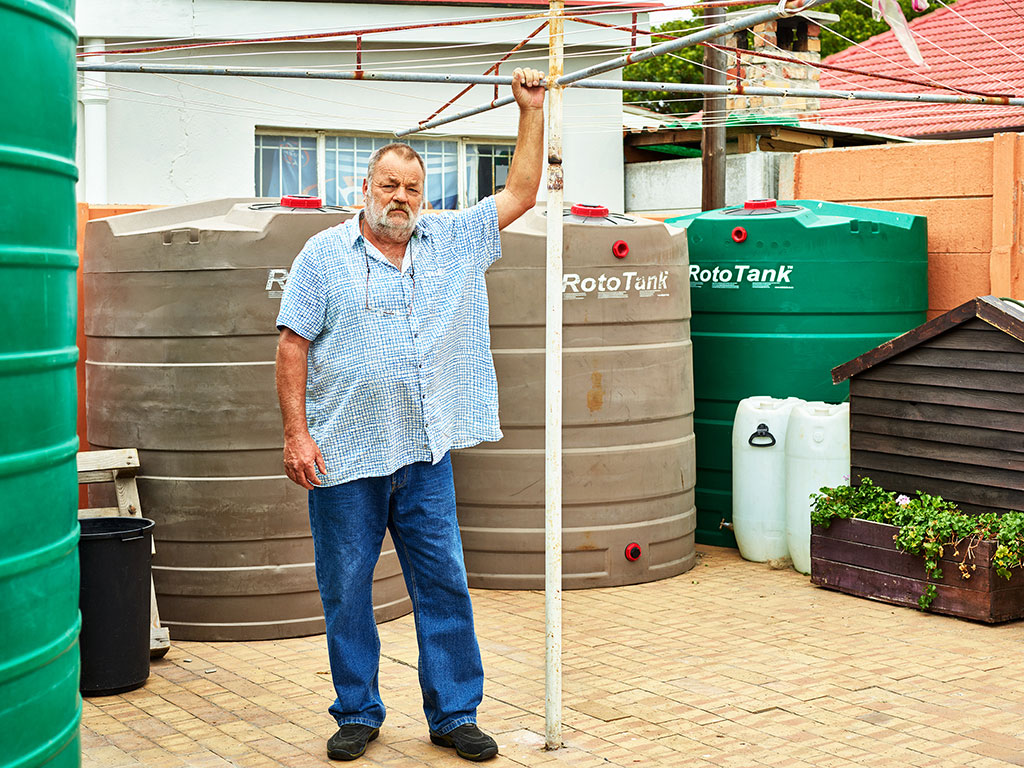
TOP: Deon Smit with extra water storage tanks in his backyard. BOTTOM: The pool at Cape Town High School.
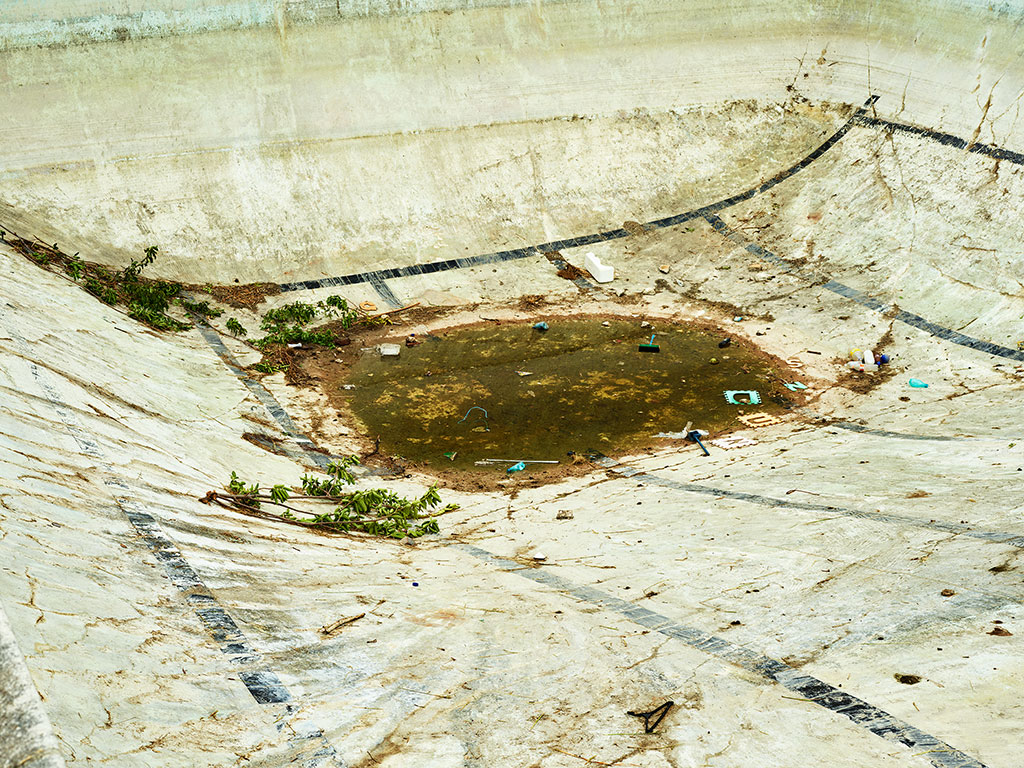
TOP: Deon Smit with extra water storage tanks in his backyard. BOTTOM: The pool at Cape Town High School.
When I started to read contemporary white South African literature, I noticed a theme was the destruction of the infrastructure of privilege, from the demise of houses, farms, gardens and swimming pools, to the breaking of gates and walls through neglect or by revenge of the historically disadvantaged. This was generally presented as a fearful scenario.
But I began to feel it was as much a fantasy as a fear. In these books, having boundaries trespassed often afforded their privileged characters a strange sense of relief. In My Traitor’s Heart, published four years before the end of white rule, the wife of a white farmer—reflecting on her reconciliation with his murderer’s relatives—says that “trust can never be a fortress, a safe enclosure against life. … Without trust there is no hope for love.”
After the coming of democracy, though, both rich and middle-class South Africans did build fortresses: high, spike-topped walls went up around houses. Many of these houses don’t even have a bell, discouraging unknown visitors. Instead, they display ominous plaques depicting a skull or the name of the security company the owners have paid to answer their panic buttons with teams wielding guns.
Spend even a little time with the wealthy or white, though, and you’ll understand how aware they are that such fortresses can’t—or even shouldn’t—hold. One friend of mine near Johannesburg mused to me recently that both he and his wife know “deep down” that white people in South Africa “got away with” hundreds of years of injustice. His wife almost never admits this, or reveals any ambivalence about their four-bedroom house and self-isolating lifestyle, for fear of making herself “a target for retribution": In other words, that ceasing to defend the goodness and justice of the white lifestyle might legitimize crime against whites or the expropriation of their land. Privately, my friend suspects “the opposite”—that keeping mum and apart is what inflames black anger. His wife’s view generally wins out, as it seems the more prudent. But what if there were a nature-made excuse to tear down those walls and try out a different kind of life? Would it really be so bad?
A historian of behavior during disasters, New York University’s Jacob Remes, told me that while “sudden” disasters—like hurricanes or earthquakes—prompt a brief upswell in feelings of community-mindedness, there’s not the same evidence for slower-moving catastrophes. And it’s predicted, he said, that the wealthy will try to “buy their way out of” any inconvenience. “When my students hear the word ‘commons,’ they think ‘Tragedy of,’” he said. What I described in Cape Town made him wonder if the higher classes weren’t waiting for a chance to demonstrate to their neighbors, and themselves, that “there really is such a thing as society.”
Toward the end of my visit, Smit said he wanted to show me his lawn, a pitiful dustscape. “You couldn’t believe how emerald it was,” he told me, shaking his head.
Many wealthier Capetonians treasure their gardens. They function as tiny little nations, carefully manicured Edens supposedly untouchable, behind their walls, by the volatility of the now-integrated communal space. “That little lawn in front,” said Smit, “was my little kingdom.”
But when I asked him whether it made him feel sad that his lawn had died, he just laughed.
“I have to adapt,” he said. “It’s gone. So what?”
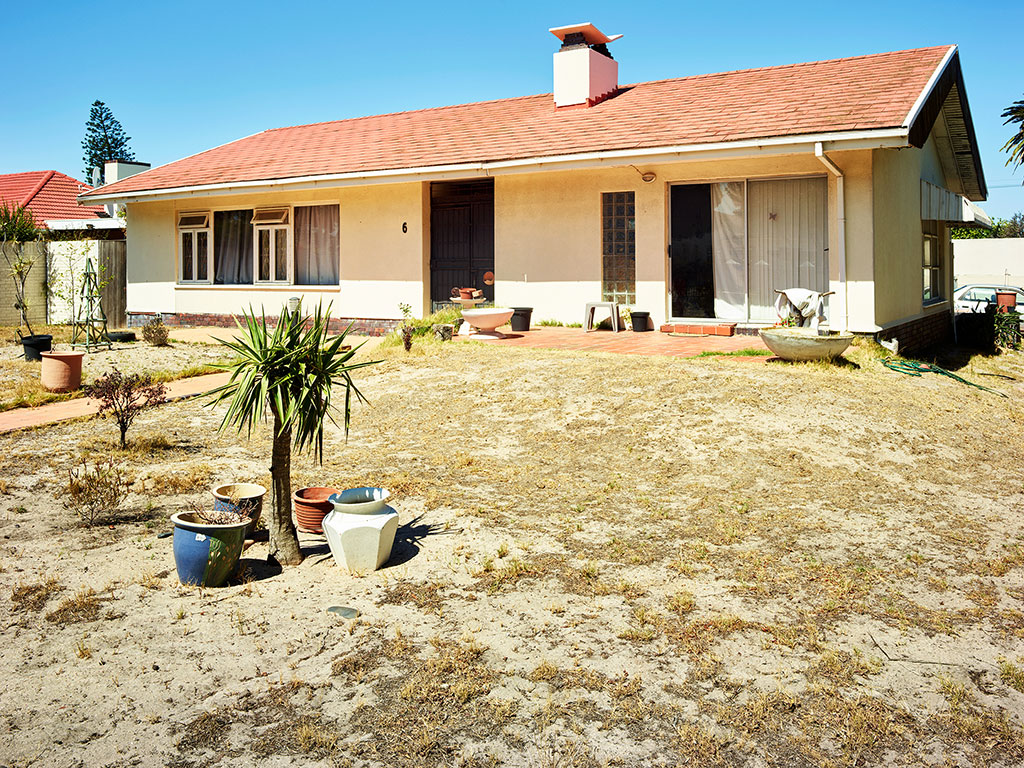
TOP: A once-mighty lawn laid low. BOTTOM: A very different take on garden care in the middle of an historic drought.
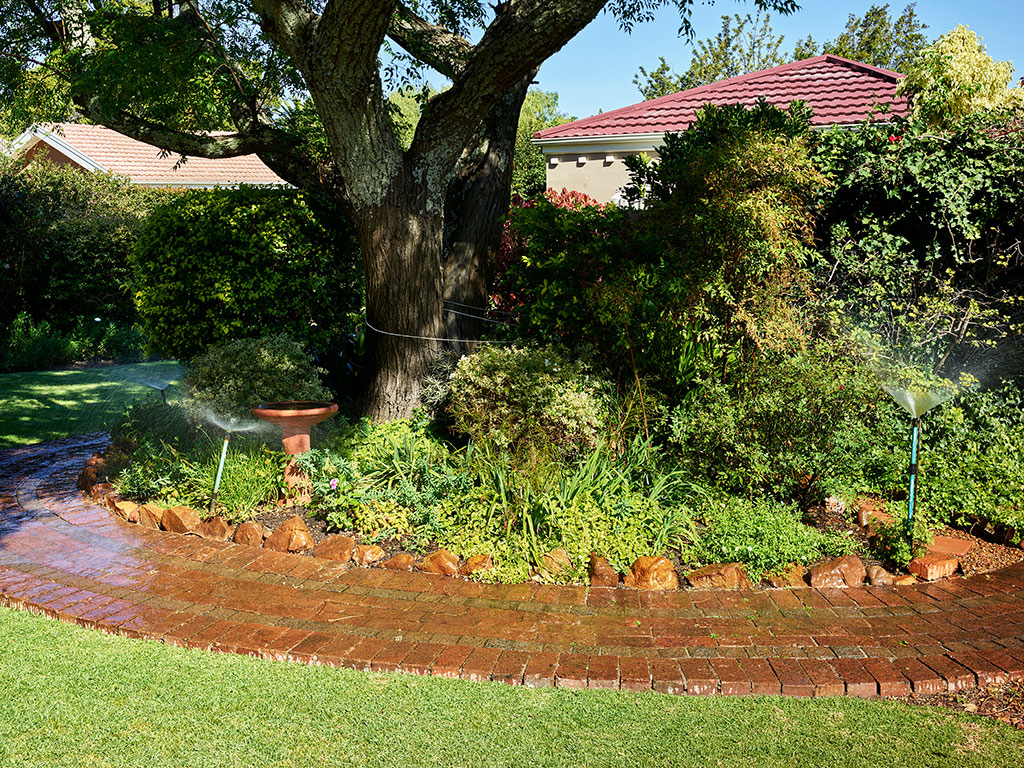

Still life with garbage can.
In a formerly “white” neighborhood called Newlands, thousands of Capetonians line up each day to gather water from a natural spring that, save for a police booth to oversee parking, is completely unmanaged by any authority. A 42-year-old Indian man, Riyaz Rawoot, labored for 14 months to create the spring’s infrastructure—a long contraption made of concrete, bricks, metal stands and PVC hosepipes that diverts water into 26 outlets before which an extraordinary diversity of people kneel with jugs, as if at a Communion rail.
Anwar Omar, whom I’d met through the Facebook page when I told him how much I liked a shower he had made out of an insecticide sprayer, insisted I see the spring. He volunteered to take me there on his motorcycle. He said I would see something that would “change my views of what was possible in the world.” Rawoot, he explained, had built the infrastructure because he comes from an ethnic background where “everybody shares.”
The interesting thing is that the spring sits in a neighborhood that, before it was white, was mixed-race—the kind of neighborhood that, in South Africa, tends to be a source of special tension, because even relatively longtime homeowners worry that the descendants of residents evicted decades ago could lay a legal claim to the land. In fact, Rawoot’s ancestors had lived two blocks away from the spring. “People from everywhere in the Cape Flats are going there,” Omar whispered to me. The legal process for land claims is very complicated; he presented the influx of people to the spring as a sort of quiet, extralegal reclamation. Some come from as far as Mitchell’s Plain, a township more than 10 miles away. “They want to go back to their waters.”
Cape Town needed an act of God—or at least some kind of really, really big, fat, awesome machine.
The even more interesting thing is that, despite this, many white residents seemed to enjoy the mood of the spring, too. It was, indeed, incredible. It was a mob scene—60 people in flip-flops, bathrobes, headscarves, shalwar kameez, tony private school uniforms, surf shirts and the form-fitting clothes popular in the black townships swirled around Harleys and busted-up old bicycles, pushing jugs of water back and forth in strollers, in shopping carts, on homemade trolleys and on skateboards. Backpacks and empty water bottles were strewn everywhere, like in a high school hallway at lunchtime. A 16-year-old kid was doing handstands for a little crowd. “Shaheed, stop,” an embarrassed girl, probably his sister, begged.
“No!” a couple of people in the crowd—a group which more closely resembled South Africa’s on-paper demographics than anything I had ever previously seen—shouted. Rawoot was handing out grape popsicles.
But there was also something reverential about the mood: People slid gracefully around each other, softly pointing one another toward the best-flowing outlet, guiding other people’s trolleys, handing back filled jugs in organically assembled lines. These days, utopian dreams that people could manage themselves in a completely non-hierarchical situation have mostly died; anarchism is a sound for high school thrash bands. But at the spring it felt as if the dream had arisen again. The situation just worked, naturally. On the left side of the spring, one hose was problematic; its stream was too fierce. Through unspoken lines of communication, people realized that somebody needed to hold it still, and seamlessly, a guy vaping in a Ducati T-shirt gave way to a young black woman, who, after 10 minutes on hose duty, gave way to Abdulrahman.
Abdulrahman, an elderly Muslim man, told me he had toiled for 48 years in the townships as a soda hawker. He sold refreshment. He was tired of selling it. He wanted to give. A few weeks earlier, he had come to the spring to fill up some jugs and found himself holding the hose for an hour. Two days later he made the 10-mile trek back—just to hold the hose. He intentionally wore shoes “with holes in them so the water runs out,” he told me, howling with laughter.
He was soaked from head to toe. When I asked him why he did this unpaid work, he looked at me and laughed again, as if it should be obvious. “Everybody’s stressed,” he said. “Everybody’s rushing.” Thanks to him being at the hose, “people can relax!”
He also seemed to take pleasure from the feeling he had managed to figure out a special hose angle that made the stream especially efficient. “Does it go quickly?” he asked a blond stranger, hopefully. From her neck hung a cross.
“It is amazing,” she said. He beamed with pride.

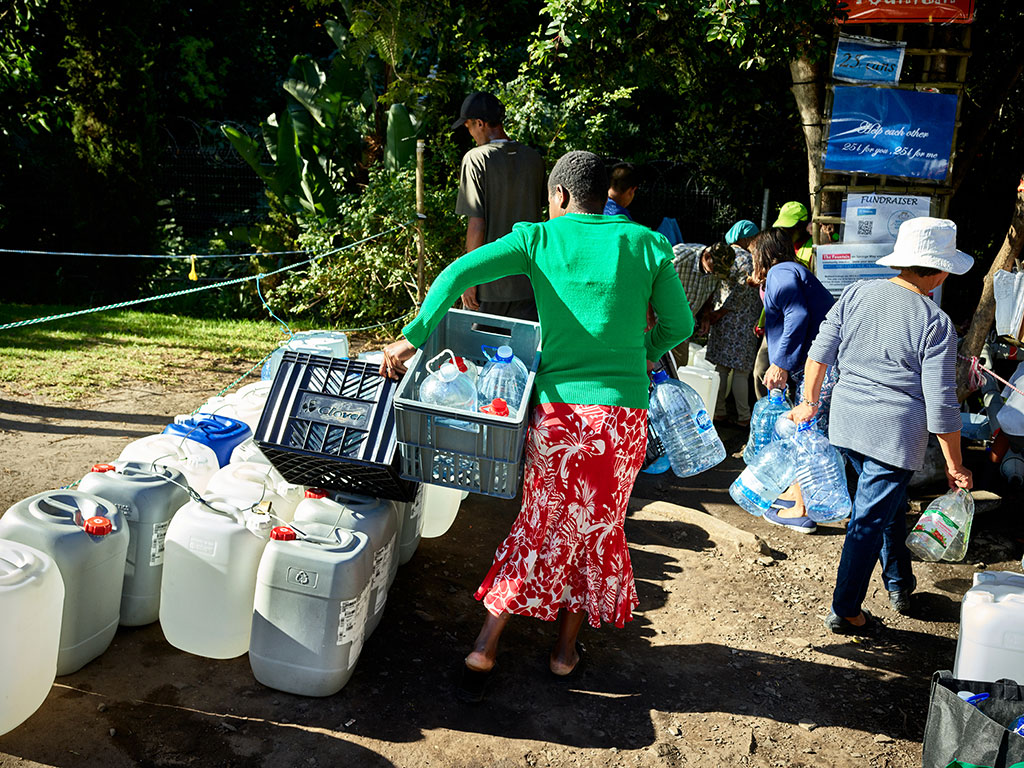
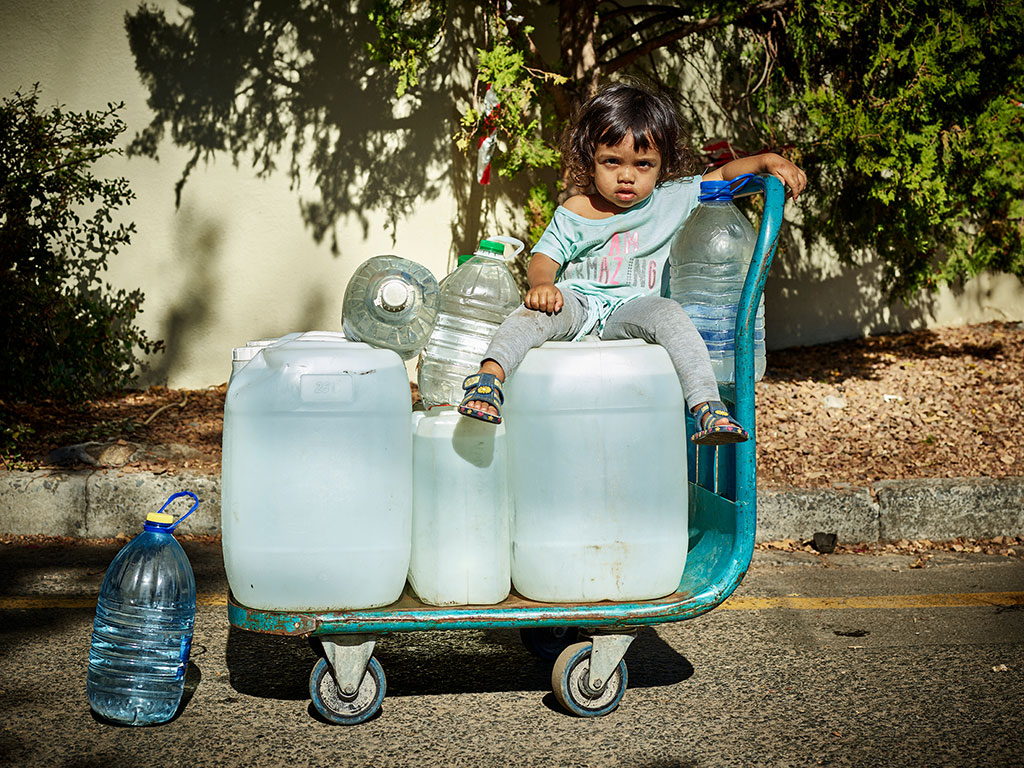
Scenes from the Newlands spring.
Rawoot, who built and paid for the pipes that distribute the spring water, is a physiotherapist. Leading me to his “office” at the spring—a patch of cigarette-butt-strewn dead grass—he told me he loves guiding people from “pain to pleasure,” touching their bodies more intimately than a regular doctor would. Pain, Rawoot mused, is “like a beaten path.” There might be an original injury, but after time, the body and the soul become so used to pain they still feel it, even after the injury is officially healed.
Rawoot’s job is to put his hands on his patients’ bodies and move them, subtly rearrange their parts. Not to “fix” them, but to help them become aware that they already have the capacity, latent inside them, to feel differently.
As a kid, he explained, he had been bewildered and saddened by South Africa’s “whites only” signs. Officially classed as “Indian,” Rawoot’s own grandmother had white heritage, and “my dad’s lighter than you,” he told me. “I thought, We’re a family, and we’ve got different shades here, and we’re fine. So why are they”—whites—”different? Why?”
He used to go with his aunt to the central train station, where whites, coloreds, Indians, Chinese and blacks mixed in the main hall—though they were going different directions. The image of that swirling cosmopolitanism stayed with him. It was what he had hoped for when Nelson Mandela became South Africa’s first black president in 1994. “But it didn’t really happen,” he said, gazing out on the spring.
Instead, 15 dusty miles from Newlands, in Khayelitsha, the vast, million-strong township built in the ‘80s for Cape Town’s black residents, most families live in shacks and suffer from food insecurity. Cindy Mkaza—an educator who grew up and works there—told me the fun of the drought hadn’t quite reached her pupils. Most of them don’t have gardens or showers anyway, and for years, the under-resourced water supply has cut off without notice. “It’s like they were already in that [drought] life,” she said. Significantly more problematic was the fact that, in the townships and lower-middle-class neighborhoods, there are often many more people living in a single home than in the wealthy areas, and the city’s water restrictions don’t take the size of the household into account unless a resident undertakes an onerous appeals process. Shaheed Mohammed, who lives in another impoverished township called Athlone, recounted to me that his neighbor had to awaken each morning at 4 a.m. to harvest water in buckets from the tap for his large extended family before a restrictive device that the city placed on his plumbing itself woke up, kicked in and cut off the flow.
When I told Mkaza about the woman on the Facebook page who said she felt “humbled” having to worry about water, she just laughed. She said her mother’s neighbors, who could rarely afford the $3 it takes to hop a minibus taxi into the city, were unaware of richer Capetonians’ efforts: “They assume affluent people are upset, and like, ‘Oh my God, I’m not going to be able to swim?’” And she worried that if things really got out of control, middle- and upper-class people would still have more options than the poor have: to drill a borehole, to move away.
Mohammed did sense a new curiosity from white or higher-class neighbors he wasn’t used to feeling much love from, or for. “It’s actually been fascinating,” he admitted. “There’s a new mindset. A shift.” At meetings he attended for a group called the Water Crisis Coalition, whose membership is primarily people of color, he’s noticed Capetonians he doesn’t normally see coming to the townships—white folks, wealthy folks, even a Zionist. “It was tough, because a majority of us are pro-Palestinian,” Mohammed said. “A couple of people didn’t want that guy to be at the meeting. But the rest of us said, ‘If you want to have a special meeting [about Israel], go outside.’”
Historically, Mohammed reflected, in so many ways, “we’re on the margins. But we’ve always dreamt of this type of unity. We haven’t been sure whether the rhetoric sometimes put out that whites are the ‘colonialists’—always the oppressor—is really true, or has to be true.” Mohammed was pleased to see that his new allies had been willing to contribute some skills and resources he and his companions didn’t have. “These people often have easier access to the Internet. They can lodge objections to the government’s treatment of larger households.”
More than that, Mohammed felt touched by the whites’ and wealthier people’s recognition of his utility. At one Water Crisis Coalition meeting, white attendees praised a giant march people of color held in the 1960s to protest racial injustice, as an inspiration for how people can band together for change. One white woman told him: “We need the support of the Cape Flats. Without the support of the Cape Flats, we are nothing.”
In South Africa, generally, the wealthy lifestyle has been considered the most worthwhile lifestyle. This is one of the country’s enduring wounds. But the drought has liberated people, at times, to acknowledge a wider range of helpful behaviors and forms of knowledge—amateur knowledge as well as expert, “non-white” knowledge as well as Western. One upper-class Capetonian told me he learned how to create his DIY rainwater-harvesting system by watching a YouTube video uploaded by an elderly man on the Cape Flats. Palesa Morudu, a black Capetonian who publishes fiction for teenagers in the townships, recalled hearing another black Capetonian on the radio say he felt satisfied that rich people now seemed to respect elements of his so-called “poor” lifestyle as actually more economical and ecologically sound than the way they had been living.
The drought had prompted changes far beyond attitudes to water. A car guard in a rich neighborhood told me he’d noticed residents walking on the street more—something that, in certain South African neighborhoods, the wealthy almost never do. At his spring, Rawoot called my attention to a group of porters who earn coins by pushing people's jugs. In South Africa, informal laborers, like car guards, often clash with each other over their turf. But, here, the porters who’d arrived most recently were sitting patiently on a curb, ceding business to the more veteran workers. “They now spontaneously treat each other with a different kind of respect,” Rawoot said. “[It is a] culture of courtesy.”
It is a primary human fear that, without imposed order, people, especially those who have long been at odds, will tend to descend into every-man-for-himself brutality; even more so these days, when Brexit and Trump, for some, have made the popular will synonymous with self-destructive tribalism and elites like the managers of Cambridge Analytica inform us that human beings are just bundles of volatile fears and longings for power that respond only to the crassest manipulation. We call it wisdom, now, to assume people are motivated by things like self-interest, status and fear. It’s not savvy to wonder if we can be motivated, en masse, at times, by things like the wish to show respect, or by love.
THE POWER VS. THE PEOPLE
I went to see Lance Greyling, Cape Town’s director of enterprise and investment, because he promised to tell me something few people understood about the drought.
In the city government building’s vast and modern entry hall, tourists snapped selfies with a five-story-high picture of Mandela.
Banners advertised the mayor's top priorities: HIV prevention, housing developments, community gardens.
There was no mention of the drought.
Greyling admitted he barely even heard the word “water” when he joined the government in 2015. Rainfall patterns had been gently trending downward for decades, but an electricity shortage seemed much more urgent. Then the awareness of a potential drought crisis escalated rapidly. By May 2017, the mayor was leading a prayer session at the foot of Table Mountain to beseech the heavens for rain. Anthony Turton, a leading water-management expert, declared Cape Town needed an “act of God.” God, or some kind of really, really big, fat, awesome machine.
Greyling, a jolly 44-year-old, laughs, now, at the desperate ideas the government solicited so it didn’t have to rely solely on Capetonians to change their behavior: A desalination barge from Saudi Arabia. Towing an iceberg from Antarctica. Every option was so expensive. One of the repeatedly asked questions was, “Can we even ask the citizens to pay for any of this?”
In November, the city hired strategic communications specialists, who felt that the best course of action was to freak people the hell out. Greyling’s revelation was that it wasn’t only nature that had prompted Capetonians’ mind-shift. Abandoning their formerly gentle, cheerful entreaties to save water, city officials placed a wild bet on fear-mongering, shaming and force. They deployed the water-restriction device Mohammed mentioned—popularly called the “Aqua-Loc”—which acts on heavy water users like a bariatric-surgery band acts on the stomach: If you even attempt to draw more than the current daily water allotment, it just shuts off your taps. Technicians are now installing 2,500 such devices a week. And in January, the mayor declared the ominous “Day Zero” was no longer a possibility but a near certainty. The provincial governor warned of impending “anarchy.” “Up till now,” the governor added mournfully, “over 50 percent of [Cape Town] residents have ignored entreaties to save water.”
We might turn out to be more willing than we expect to live a harder way.
It worked. City officials saw water consumption plummet. The shameful revelation that half of Capetonians were outright ignoring the disaster caused particular hand-wringing on the Facebook page, as well as determined vows to do better. But Greyling told me he knew the government’s most dystopian claims were “not exactly true.” The majority of people in Cape Town had reduced their water usage, though some hadn’t managed to get below the restriction. The implication that “Day Zero” was some God-given red line after which the city’s taps would “run dry” also wasn’t quite accurate; it simply represented the dam level below which the city had judged it would need to more aggressively ration water.
In a sense, these actions were extremely courageous. Greyling said the message the government wanted to send the public was, in part, “Look, guys, we haven’t got this completely. This is actually in your hands.” For a government to lead with force while simultaneously admitting its limitations—instead of promising the world in return—is a stunning reversal of the way contemporary politics are practiced.
But the government hasn’t gotten much credit for this. Nor will it, probably. Daniel Aldrich, a disaster resilience researcher at Northeastern University, told me that his multi-country research suggested that a loss of trust in government after a disaster was typical, even inevitable. He’d conducted extensive fieldwork in Japan after the 2011 tsunami, which, he said, helped turn Japan from “one of the most trusting countries to the least.” People forge new bonds in the face of a common enemy, initially nature, he explained; once that enemy dissipates, though, unhappy at the thought of giving up their new faith in each other, they look around for a new target.
Moreover, the thing that especially pisses people off during a disaster, he said, is the sense that they’ve been manipulated. “Anything that you do that’s going to make citizens think you’ve lied to them is going to be a much longer-term problem,” Aldrich said.
Another unfortunate downside to any successful campaign to reduce people’s consumption of a government-managed public good is a drop in government revenue from the taxation of that provision. Cape Town had a “step tariff” taxing heavier water users at a higher rate per liter, so its success at shaming the greedy wealthy ended up sort of backfiring. At a time when the city still has to contemplate even greater water scarcity due to climate change and population growth, and look into pricey infrastructure projects, it is grappling with a massive $166 million budget shortfall in the Water and Sanitation Department. To address the shortfall, in December, the city proposed an additional tax on water. People were very hurt. You said we did so well, and now you want to punish us for what we’ve done?

Looking for a refill.
When the leader of the mayor’s party announced in early March that Capetonians ought to celebrate their drastic water-consumption reduction and that they might have averted Day Zero, residents seethed instead. Some called the government dumb for telling the updated truth, potentially freeing citizens to return to their lazy ways. Others wondered if the crisis had been entirely fabricated in order to get them to pay higher taxes. A few even piloted drones over Cape Town’s largest dam to see if it was secretly full of water. (It wasn’t.)
“In the effort to light a fire under people’s asses, the city government might have lit a fire under their own asses,” John Nankin, one of the Capetonians who posted a drone photo of the dam to Facebook, told me. “When we vote again, I don’t think people will forgive them.” By 2025, half of the world’s population will be living in water-stressed areas. This makes Cape Town a funny case: On the one hand, a template for how to daringly and effectively handle a daunting resource crisis; on the other, a potential cautionary tale about how forceful leadership may end in the community turning against the government, crippling future problem-solving.
By the time I visited Cape Town, an ever-amplifying distrust and hostility loop between government and the citizens seemed to be settling into place. It’s not our fault, it’s all your fault, was how Greyling characterized the feedback he’d been getting. He seemed hurt by this. I found officials associated with the city government more and more seemed to buy their own initially tactical line that citizens were ignorant or only controllable by force. Greyling sighed when we discussed Mohammed’s activist group. “I’m afraid many of their views are misguided,” he said. And when I brought up Rawoot’s spring, he groaned.
According to Rawoot, as well as a witness, the councillor for the neighborhood with the spring called him “crazy” at a March public meeting and confronted him afterwards. A professor writing a sociology paper about the spring told me some officials “couldn’t believe” Rawoot “would be doing it just to help. They insisted he must be getting money from someone to undermine the government’s image.” Though there’s little evidence citizens would blame government for mishaps at a privately managed spring, city officials have called it a public nuisance, a health hazard shambolically designed by people who lack experience in central planning. They want to divert the water to a city-managed swimming pool attended by guards, which would almost certainly destroy its spirit. “Fights were breaking out” at the spring until the city posted police there, Greyling told me. Both Cindy Mkaza, who gathers water at the spring, and the professor said that fights are exceedingly rare. When I described the beautiful scene I experienced at the spring to another person who has worked for the government, he warned me, “I don’t have any other facts. But assume there’s a lot more to know about this if you want the whole story.”
When I returned home to Johannesburg, I flushed the toilet. But I paused before doing it, to think. A therapist once encouraged me to go on vacation to a different locale with a boyfriend I was struggling with, saying the location change might help us see ourselves in a different light. “But we’ll just come back home to the same place,” I objected.
“A memory,” she said, “is also a possibility.”
It’s true: We can only really imagine what we have already experienced. That’s why the aliens in science-fiction movies look like human beings. It’s actually a hopeful thought. In general, we agree that we face the unimaginable: resource competition, continuing globalization and its attendant cultural stresses, the potential fissuring of the economic system on which modern civilization has been built. The feeling is that the longer we wait to avert these changes, the harder it will be to deal with them.
James Workman, a writer and water analyst, captured the prevailing anxiety in his 2009 book Heart of Dryness. “We don’t govern water,” he wrote. “Water governs us.” Without some certainty around this critical resource—with its steady presence, largely hidden in industrialized society, made more unpredictable by climate change—society could fall apart. “The unvarnished anthropological record of human nature,” Workman worried, shows that "each of us looks out for his or her personal interest." People left ungoverned by something they can fully trust and rely on won't be able to govern themselves.
Cape Town suggests an opposite possibility. It could be that human beings are just waiting for something that gives them a challenge, a chance to rise above their politics-exhausted cynicisms and prove they can be good neighbors, stand for more than just money and success, and find ingenious tricks, together, to outwit their new tormentors. It could be that certain kinds of disasters—particularly the natural, which feel more neutral and acceptable than politically driven ones—may wedge open spaces for change in other areas in which we feel stuck. “There is a crack in everything God has made,” Emerson said, “vindictive circumstance stealing in at unawares, even into the wild poesy in which the human fancy attempted to make bold holiday.” “The wound is where the light enters,” said Rumi. Maybe we know society’s long contemporary holiday of development and self-enrichment will soon be over. Maybe more of us than admit it are sick of it, and know we can’t pay for it much longer. Maybe we know, deep down, that we will have to go back to the work of being humans embedded in nature, and not above it. Maybe parts of this will be a relief to some of us, even a joy. We might turn out to be more willing than we expect to live a harder way.
It’s difficult to know which of the changes in Cape Town will last. But they will at least be a memory.
I remember driving from the Tarlings’ home, away from the mountains back toward Cape Town, when, unpredicted by the weather service, it began to pour rain. I get a lot of rain in Johannesburg. It’s a pain; our roof leaks. It was nighttime, and I didn’t know the neighborhood. But still, on a new instinct, or a dormant one awoken, I swung over to the side of the road and quietly watched the drops on my windshield gather and catch the glow from the streetlamps, like the swirl of lights that introduces a movie on a cinema screen, or the birth of a tiny universe. I logged onto the Facebook page. Four hundred people had posted already. “Just told a room full of people in a meeting and we all cheered!” Lesley wrote. “Take an umbrella but we are not gonna stop the rain,” Moegsien wrote. “Raining in Mitchell’s Plain now,” Carmelita wrote. “Raining in Sea Point,” Gillian wrote. “Thank you, Lord! Our precious Redeemer!” Cobie wrote. “Algamdulilah,” Bahia wrote. “Thank you Rain Fairy!” Wayne wrote. “Praise his Noodliness. R’amen,” Roxanne said.





0 General Document comments
0 Sentence and Paragraph comments
0 Image and Video comments
dish water and washing machine water fills toilet tanks
New Conversation
Hide Full Comment
Looks like regular people also helped solve issues, rather than waiting for someone else to do it
New Conversation
Hide Full Comment
The lack of water has created more mingling between the classes and cliques of people
New Conversation
Hide Full Comment
General Document Comments 0

